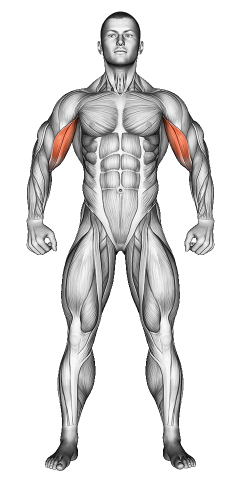Standing Hammer Curl: Video Tutorial & Exercise Guide

Written By: Claude Michael
Updated: Oct 13, 2024
| Workout | Standing Hammer Curl |
| Primary Muscle Group | Biceps |
| Secondary Muscle Group | Forearms |
| Equipment Required | Dumbbell |
| Force Type | Pull |
| Mechanics | Isolation |
| Exercise Type | Strength |
| Difficulty | Beginner |
Standing Hammer Curl: Video Tutorial & Exercise Guide
- 1.Standing Hammer Curl: Muscle Groups
- -1.1Primary Muscle Group
- -1.2Secondary Muscle Group
- 2.Standing Hammer Curl: Step-by-Step Guide
- 3.Standing Hammer Curl: Overview
- 4.Standing Hammer Curl: Benefits
- 5.Standing Hammer Curl: Pro Tips & Advanced Techniques
- 6.Standing Hammer Curl: Progression Plan
- 7.Standing Hammer Curl: Frequently Asked Questions (FAQs)
Secondary Muscles Group
Standing Hammer Curl: Step-by-Step Guide
- Step 1: Stand with your feet shoulder-width apart, holding a dumbbell in each hand with a neutral grip (palms facing each other). Keep your arms fully extended by your sides.
- Step 2: Keep your elbows close to your torso, your back straight, and your core engaged. Let the dumbbells hang down naturally at your sides.
- Step 3: Begin curling both dumbbells upward by bending at the elbows, keeping your upper arms stationary. Focus on contracting your biceps and forearms as you lift.
- Step 4: Continue lifting the dumbbells until your forearms are fully contracted and the dumbbells are near shoulder height. Pause briefly at the top to squeeze your muscles.
- Step 5: Slowly lower the dumbbells back to the starting position, maintaining control throughout the movement. Repeat for the desired number of reps.
Standing Hammer Curl: Overview
The Standing Hammer Curl is a highly effective exercise that targets the brachialis and brachioradialis muscles in addition to the biceps. The neutral grip used in this exercise reduces strain on the wrists and engages the forearms, making it a great option for those looking to build both arm strength and forearm size.
Suitable for all fitness levels, the Standing Hammer Curl is a key addition to any arm workout routine, helping to improve overall arm aesthetics and strength while providing variety from traditional bicep curls.
Standing Hammer Curls: Benefits
Standing Hammer Curls are excellent for building thicker, stronger arms by targeting the brachialis, a muscle underneath the biceps that contributes to arm size. The neutral grip also engages the brachioradialis, promoting better forearm development.
This exercise helps improve both grip strength and wrist stability, making it beneficial for athletes and lifters. Additionally, the Standing Hammer Curl reduces wrist strain compared to traditional curls, making it a great option for those with joint issues.
Standing Hammer Curl: Pro Tips & Advanced Techniques
Focus on slow and controlled reps to maximize muscle activation. Avoid swinging your body or using momentum to lift the dumbbells. For an added challenge, you can alternate arms or perform slow negatives (eccentric phase) to increase time under tension. You can also hold the contraction at the top of the movement for 1-2 seconds to further engage the brachialis and forearm muscles.
Standing Hammer Curls: Progression Plan
Beginner
Intermediate
Advanced
Standing Hammer Curl: Frequently Asked Questions (FAQs)
What muscles do Standing Hammer Curls target?
+Standing Hammer Curls primarily target the brachialis and brachioradialis muscles while also engaging the biceps and forearms.
Are Standing Hammer Curls good for beginners?
+Yes, this exercise is beginner-friendly. Focus on lighter weights to perfect your form before progressing to heavier dumbbells.
How often should I do Standing Hammer Curls?
+Include Standing Hammer Curls in your arm workout 1-2 times per week, allowing for adequate recovery between sessions for optimal muscle growth.
What common mistakes should I avoid?
+Avoid using momentum or swinging the dumbbells. Keep your upper arms stationary and your movements controlled to fully engage the muscles.
Can I perform this exercise with other equipment?
+Yes, you can perform Hammer Curls with kettlebells or a rope attachment on a cable machine for variation. These options still maintain the neutral grip and target the same muscles.
Share
Don’t Wish for It, Work for It – Join the FlexXP Newsletter Today!
Thank you for signing up for the FlexXP Newsletter!
This site is protected and the Google Privacy Policy and Terms of Service apply.

